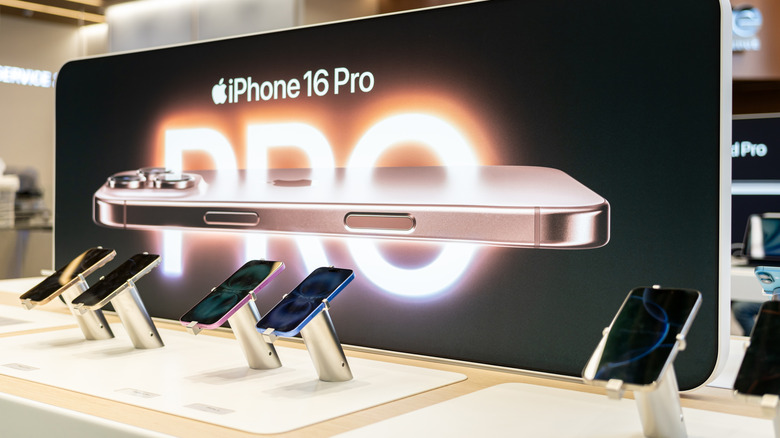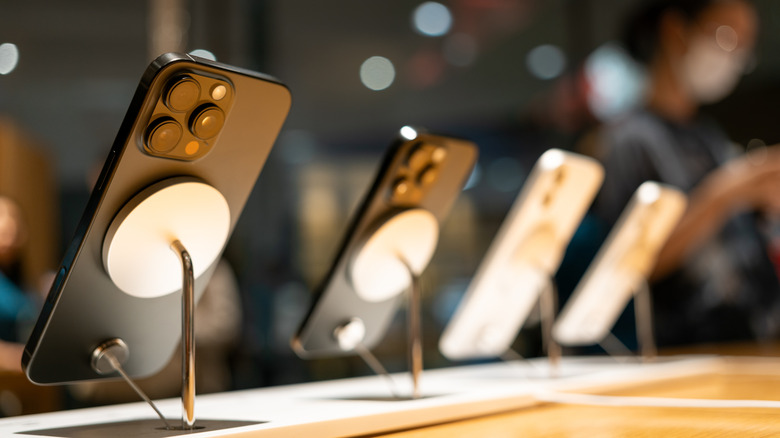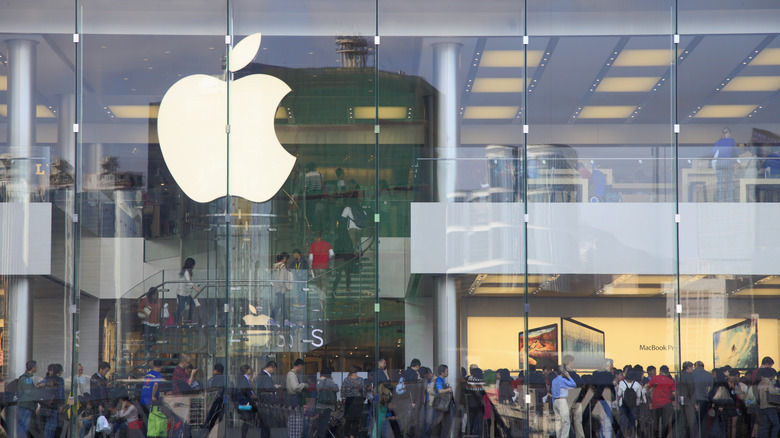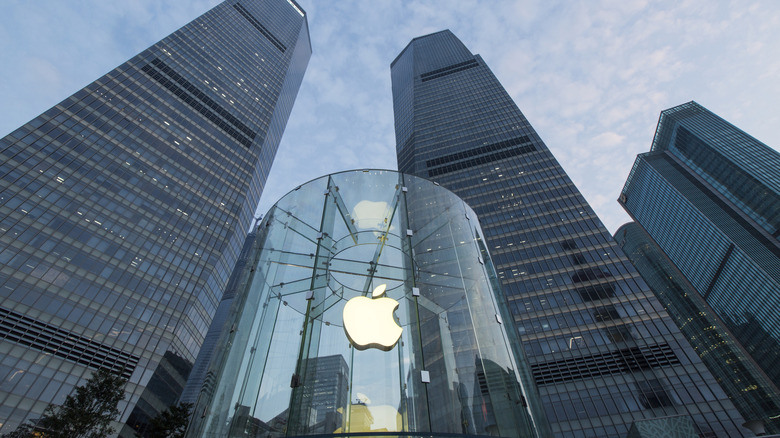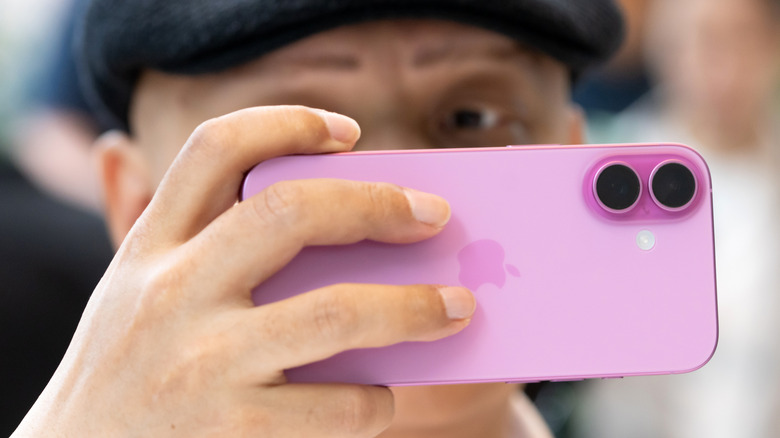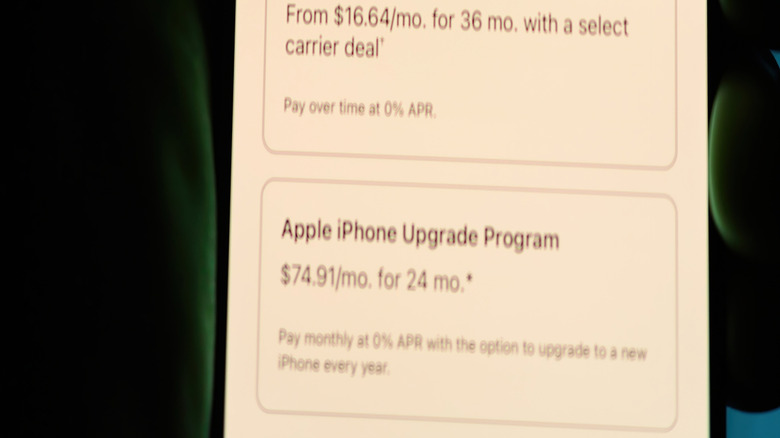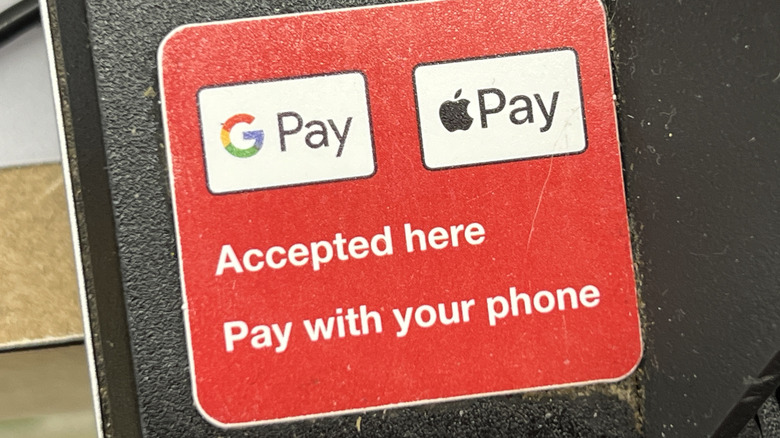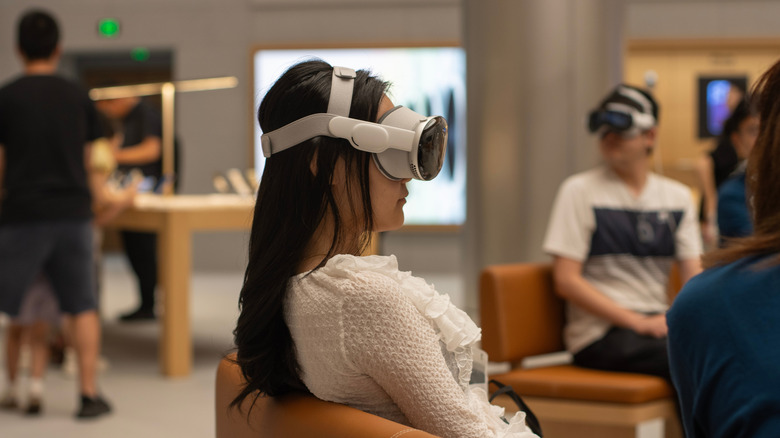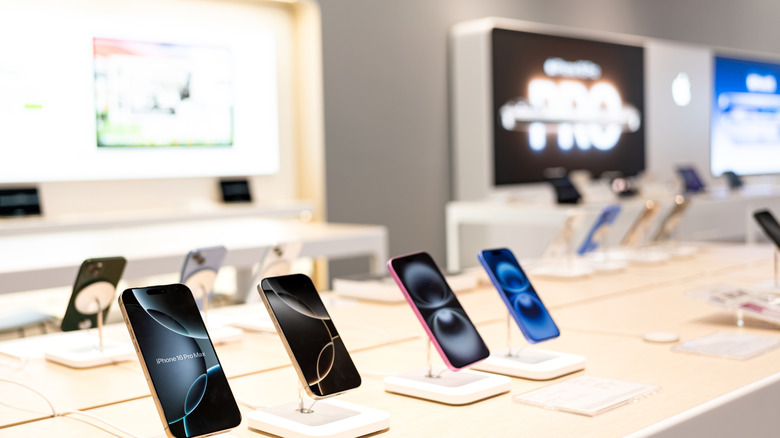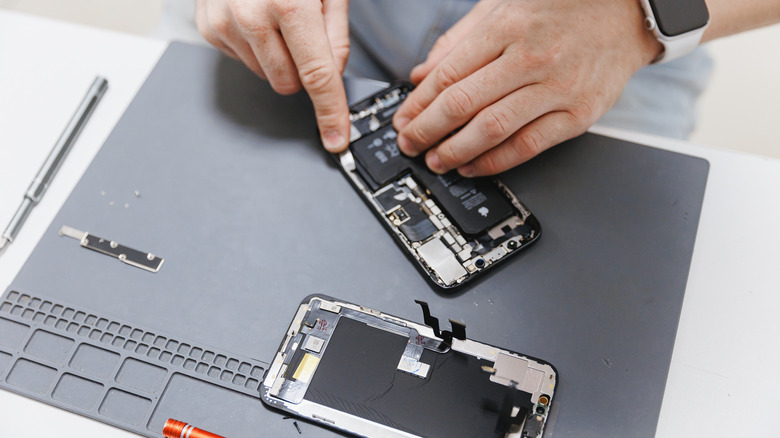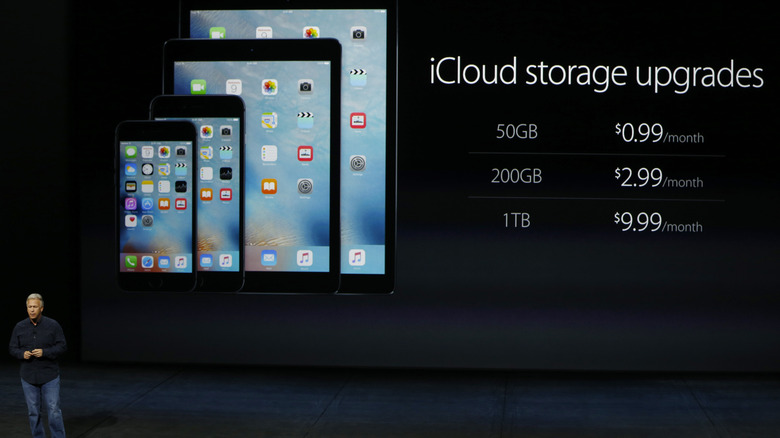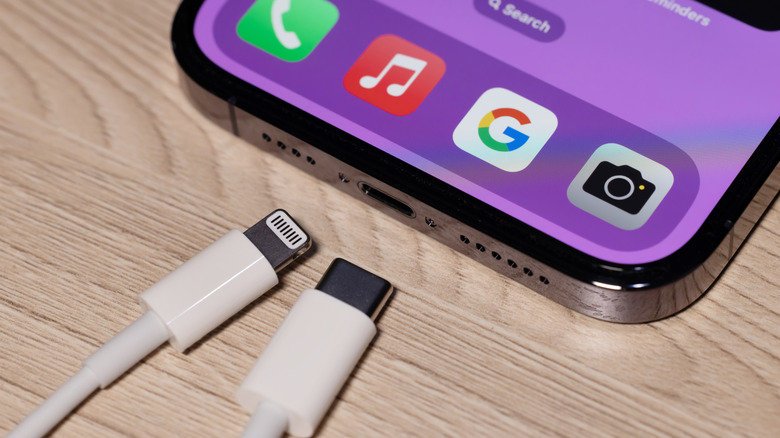11 Sneaky Ways Apple Gets You To Spend More Without Realizing It
Apple Inc. is a global phenomenon. Born as the Apple Computer Company in 1976, it produced personal computer devices for decades before eventually pioneering the modern smartphone — a device that could combine numerous everyday tools under the hood of a single handheld technology. When the iPhone hit markets in 2007, Apple launched itself into a new universe of profitability and revenue generation. Today, the iPhone is by far the brand's most important product, with other tools like Mac computers and iPads taking a backseat. Smartphone technology is continually advancing, and the future of these communication tools looks pretty bright. iPhones are constantly pushing the envelope forward, alongside devices from other brands, reimagining what the cellphone is and can be. It was only about 50 years ago that the first cellphone call was made, and we can only begin to imagine what phoning will look like another 50 years into the future. One thing's for sure, Apple will look to be a big part of that future. The company is the most valuable brand in the world today, valued at over $3.5 trillion.
It didn't get there by accident — Apple uses intelligent and sometimes sneaky physical, commercial, and psychological tricks to get people to spend money in its stores, both online and offline. Buying Apple gear has become a cultural experience, but the company doesn't sit back and wait for its customers to come to it. These are some of Apple's most important strategies to get you to spend money.
Apple stores display prices on small placards
In virtually any retail setting, interacting with a salesperson rather than simply browsing on your own will result in higher customer conversion and total spending on the whole. If left to your own devices, you might simply wander around the store looking at things or pick out exactly what you had researched before leaving the house. Accessory additions, upselling to a higher-spec model, and other service inclusions typically only come into play when a salesperson gets involved in a customer's experience. The Apple Store is frequently staffed by a large number of sales associates, known as "Geniuses." These Geniuses actively engage with nearly everyone who walks into the building.
But simply walking up to someone and talking to them doesn't always achieve the outcome sales associates are looking for. Apple has found a way to stack the deck in its favor. In addition to immaculate sales floor design and stunning product displays, prices are shown on tiny placards or perhaps not at all. Apple has gone to great lengths to downplay the role of money in the Apple Store experience until the actual sale. Minimizing price visibility gives sales associates an inroad with each new conversation. At the bare minimum, an interested customer may need to ask about the price, and without cash registers in these stores, customers must initiate a conversation to make a purchase — if they haven't already been approached. All these features are designed to increase the time customers spend speaking with the brand's sales team.
That's to say nothing of the cavernous and inviting storefront
Store design doesn't stop at the displays and minimization of financial considerations. The design language of an Apple Store goes far beyond these minor details. Whether a standalone building or a storefront located in a shopping mall, Apple Stores begin with a gigantic glass facade and pristine, bright lighting. The eye is immediately drawn to the company's delicate yet dynamic Apple logo. It's a simple brand image but one that speaks tremendous volumes given the company's illustrious history of producing some of the most visually and physically appealing devices on the market. Inside, you'll see a hive of activity as you approach the doors. There are often plenty of customers buzzing around the numerous display tables inside an Apple Store, but their numbers are augmented tremendously by the array of people who work there. Rounded out by the numerous tables, seats, and other adornments themselves, an Apple Store tends to look like it has a lot going on within, even if you catch one on a slow day.
All this is by design, and the stores are built purposefully to attract as much attention as possible. Even if you're an Android user, the environment is enticing and beckons for onlookers to step inside and explore what this energetic Apple experience is all about. It's a master class in social psychology, and every Apple Store is constantly reaffirming the brand's subtle marketing strategy that suggests Apple devices tap into a community experience that shouldn't be missed — you can easily join those already in the know by simply walking in. Once you step inside, a roving team of sales associates and mobile payment options that eschew the traditional cash register line make buying something within its walls incredibly easy.
Apple Stores are the crown jewel of the Apple brand, in terms of driving sales
The effort Apple has undertaken to make its stores magnetic to consumers has paid off. In a world increasingly supported by eCommerce availability, physically interacting with the product remains a powerful business tool. People who handle goods before purchasing them are more likely to pull the trigger and walk away as newly minted owners. This is especially true for high-value items and tools that will be continuously used in daily life, such as your next cellphone. This reality of the consumer mindset certainly plays a role in Apple's persistent commitment to creating phones that look and feel like a celebration of technology. There are plenty of technical reasons why a phone user who wants to eke out the best possible technology experience might opt for a Samsung, Google, or other Android device over an iPhone – perhaps even a PinePhone that runs on Linux for the hardcore developer. Yet, there's something special that these brands can't replicate in the way an iPhone looks, feels, and responds.
Apple's eCommerce pipeline contributed to its total revenue of $383 billion in 2023. The iPhone accounts for roughly half of the company's total earnings, and the store is the device's most prominent means of display. Here, customers can handle the device and experience what it can do for themselves. Matched up with skilled sales staff, the Apple Stores are credited with a huge 26% profit margin and are known as some of the most profitable real estate in all of retail (close to $6,000 per square foot).
'Today at Apple' classes are designed to drive even more foot traffic to the retailer
Yet another tactic that Apple utilizes to generate foot traffic is its "Today at Apple" classes. Considering how successful the store is at converting visitors into buyers, Apple has focused a lot of attention on finding ways to entice people to visit its stores more often. The Today at Apple calendar includes all kinds of classes like photography, drawing, and coding. The classes also feature sessions designed to help people better understand other tools from the Apple catalog, like its Apple Watches and iPads.
Driving additional foot traffic into a retail store isn't a new phenomenon, but it's perhaps unique in the Apple ecosystem. Today at Apple classes focus heavily on ways to improve your usage experience with an iPhone specifically, the device you likely already own and yet the most prominent piece of equipment the company is trying to sell you. Whether as a result of these Today at Apple classes or other tactics employed by the company, most iPhone owners replace their device every two to three years, helping create a thriving cycle of repeat sales for the brand.
iPhone purchases are characterized by plenty of payment options designed to eliminate sticker shock
In addition to the somewhat hidden price tags that keep thoughts of money in the background while exploring a new iPhone, options to pay over time are frequent in the purchasing conversation. Sometimes, monthly payment prices are displayed even more prominently than the full cost of a new iPhone or Mac computer. This primes customers to think in terms of monthly payments rather than total purchase price, shifting their mental image of the expense into more manageable, bite-sized pieces.
The effect is a reduction in sticker shock. While Apple markets itself as a premium product supplier, the company has painstakingly worked to sell expensive devices while simultaneously driving its customers to think as little as possible about the price tag. This effectively creates more sales opportunities for the company and opens up the possibility of adding interest charges to pad its earnings over the long term.
Apple Pay entices consumers to spend more outside of the Apple ecosystem, too
Apple hardware is just one piece of Apple Inc.'s extensive product offerings and revenue model. Apple Pay is a service used regularly by over 500 million people in 76 countries. Paying with your phone rather than cash or a card in your wallet may seem like just a convenient alternative without affecting your consumer behavior. However, studies show that Apple Pay users spend about 10% more than conventional card carriers who don't use this digital wallet service for routine purchases. It would seem, perhaps, that convenience breeds complacency when it comes to routine budgeting. Relying on Apple Pay for the majority of your purchases can lead to increased spending for many.
This additional spending benefits Apple tremendously, whether you're buying directly from the company or not. Apple charges transaction fees to merchants and participating banks that allow users to add their debit or credit cards to their Apple wallet. The company drove $1.9 billion in revenue from this arrangement in 2022 alone, showcasing just how potent this service is at generating profits.
The 'endowment effect' is present in Apple Store displays
Apple stores frequently deploy psychological knowledge into their design. Everything from the social cues delivered through those huge glass windows to the placement of phones inside the store is derived from lessons in social psychology. One such lesson is called the endowment effect.
One design choice you aren't likely to notice as an active sales tactic is the positioning of iPhones and other devices on the store's tabletops. Naturally, you might assume they're placed in such a way that improves the visual aesthetics of the product, bathed in flattering light from above. True, but this isn't the main goal of their placement. Instead, Apple has carefully crafted stands and positioning language that entice visitors to pick up the device. The screen is angled in such a way that viewers are incentivized to pick up the tool in order to get a better look and its screen and features. Careful onlookers will also notice that Apple store Geniuses rarely, if ever, touch the devices themselves. The endowment effect suggests that if you pick up a product and handle it freely without a sales associate's interference, you'll naturally visualize it as your own and be more inclined to make a purchase.
Apple Geniuses offer three product choices rather than two
In addition to allowing you essentially free rein over the products displayed in a store, when conversing with an Apple Store employee you'll typically be given three products as choices rather than two to meet your communication needs. This is made simpler by the modern trend of iPhone releases tending to include four options — alongside three or four storage selections. This gives Geniuses a large and small form factor to pitch, as well as a standard or enhanced model (the "Pro" in contemporary terminology). For reference, the iPhone 16 offers a standard 16 build, the iPhone 16 Plus (featuring a larger screen), and two iPhone 16 Pro builds (standard size and a "Max" version). A sales associate can pitch one of the larger form factors alongside the Pro and standard models. They might even opt to go down a model year with an additional Pro model thrown in as the third choice if you've suggested you don't want a large device.
The reason for this rigid adherence to three highlighted products lies once again in psychology. Researchers at the University of Minnesota found that choosing from a list of three options rather than two is much easier, with the study supported by findings from brain scans of participants. Breaking the binary choice between one thing or another has become an integral part of Apple's playbook when trying to sell customers on a new device.
Words like 'bug' and 'crash' don't exist in the Apple lexicon
Science also suggests that emotionally charged words overwhelm decision-making processes and other cognitive functions. Studies on colorized word recognition tasks show that the human brain is slower at processing words with complex emotions attached compared to simpler or more sedate terms. As a result, when you walk into an Apple Store and talk about problems you've had with your phone, the Geniuses you speak with are trained not to repeat certain terminology like crash or buggy. Instead, they will guide the conversation toward lighter phrases like non-responsive or issue.
The idea is to maintain an open and communicative conversation with customers. People who are upset or closed off become less engaging with sales staff, minimizing their ability to tack on accessory sales and other profit-boosting additions. Apple Geniuses use subtle phrasing to keep the emotional temperature down and promote more active decision-making in an effort to fuel increased sales volumes while also supporting the needs of their customers.
Data storage is a soft product that translates into big business for the brand
While much has and will likely continue to be made of the design language of the iPhone, certain design choices remain the bane of many users' existence. One such problematic feature is the lack of SD card compatibility. Expandable storage is a common trait among many portable devices. SD cards allow you to compartmentalize data by saving some items on the phone and others on a removable device. The ease of removability also means that you can share files quickly and with little hassle in many instances.
But iPhones have never supported expandable storage like this. It may have started out as a design sacrifice to promote other inclusions, but modern iPhones seemingly don't support SD cards to funnel users toward iCloud subscriptions instead. The iCloud service as a product yielded $10.4 billion in revenue for Apple in 2024. Two features underpin this significant figure — the lack of SD card support to expand how much an iPhone can realistically store and the seamless data transfer when you buy a new iPhone. Moving all your stored data from an old phone to a new one takes only minutes, saddling your new device with the same storage issues as the old one. This means that when you buy a new iPhone, you are constantly enticed to purchase a model that features more storage than the last phone you carried in your pocket. And if you are not going to increase your local storage capacity, you are almost certainly going to eventually invest in iCloud services at some point or another.
Before the iPhone 15, Apple consistently shifted its cable parameters, as well
Finally, Apple has routinely changed the cable it uses to charge its devices. Always proprietary and frequently shifting in design, Apple charging cables have meant that iPhone users need to always think about a backup. There hasn't been cross-compatibility with Android users' charging cables, so bringing along a cable wherever you go was frequently part of iPhone owners' routines. Buying new cables meant returning to Apple to spend more money, and with new phone releases, your old cables were occasionally made obsolete.
The release of the iPhone 15 in 2023 changed this. As a result of a European Union ruling designed to increase convenience across platforms and reduce waste, new iPhones now feature the same USB-C connection that other devices support. Anecdotally, there is already chatter making the rounds that suggests a future shift away from charging cable compatibility altogether. Most modern smartphones support wireless charging, including the iPhone range. There's talk of a potential elimination of the charging port altogether, making users instead charge their devices wirelessly and potentially reintroducing the accessory sales pipeline that the company lost when its unique charging cable was stripped away.
